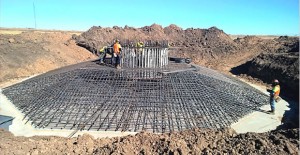Donley County Commissioners approved a tax abatement for a new wind farm Monday and received an update on the Salt Fork project already under construction.

During its regular meeting, the court consented to a ten-year one hundred percent tax abatement for what’s being called the Salt Fork II project, which is located adjacent to the west of the current project along the northwestern part of the county.
Cielo Wind Energy representative Steve Brewster said Salt Fork II will start by the end of 2016 in order to take full advantage of the federal production tax credit. This is the last year companies will be able to get 100 percent credit under that tax break as the law now stands.
Brewster said the 150 megawatt project that stretches into Carson and Armstrong counties will include a minimum of 23 megawatts of production in Donley County.
As a condition of the abatement, Donley County will receive payments in lieu of taxes amounting to the greater of $1,500 per megawatt or $75,000, annually for ten years. The first payment is expected in 2018.
Also on Monday, Vince Green of EDF Renewable Energy discussed the progress of the Salt Fork I project.
EDF purchased Salt Fork I from Cielo for development and has contracted with Blattner Energy to build the wind farm.
Construction is underway on 63 turbines in Donley County and 24 in Gray County, Green said. Foundation and ground work is being completed, and turbines are expected to start arriving this week with the goal of being in full production by the end of 2016.
The substation for the project and the operations and maintenance building are both located in Donley County. Additionally, Green said another 27 turbines are expected to be erected in this county in Phase Two of the Salt Fork I project (which is not the same as Salt Fork II).
Garland Power & Light has agreed to purchase 150 MW of power from Salt Fork I, and another 24 MW has been contracted to Salesforce.
The Salt Fork I project represents a $235 million investment. Green reported that 100 people are at work on the site. He said about 75 attended a hiring event in Pampa last year, and two were hired by Blattner.
Green also reported that $467,187 had been spent locally so far on the project for food, lodging, water, and caliche.
County Judge John Howard asked Green to supply a more detailed breakdown of the local spending, noting that sales tax revenue for the City of Clarendon has not reflected an increase in local spending. Commissioner Dan Sawyer also said he doesn’t see construction people in Clarendon and reminded Green that the project is supposed to produce some full time employees.
Green said the full time positions are in the total project and said that construction workers are likely going to Groom most often for meals and groceries since its closer to the job site. But he said he would get a more detailed report on local spending to the county.
Green also reported that EDF has sub-graded the roads near the project and placed a two-inch caliche cap on 71,000 feet out of 124,000 feet of roads in the project.
When the first phase of the Salt Fork I project is completed, it will be comprised of 87 V100 (unit capacity of 2.0 MW) wind turbines supplied by Vestas.
The amount of power generated will be equivalent to avoiding more than 510,000 metric tons of CO₂ emissions annually, according to an EDF press release. This is equivalent to the emissions of 107,000 passenger vehicles driven over the course of one year.


Leave a Reply
You must be logged in to post a comment.